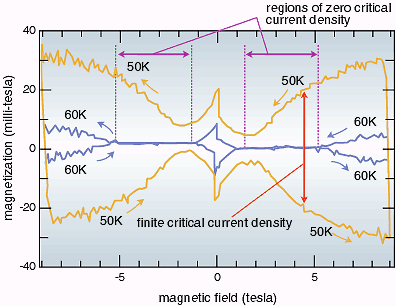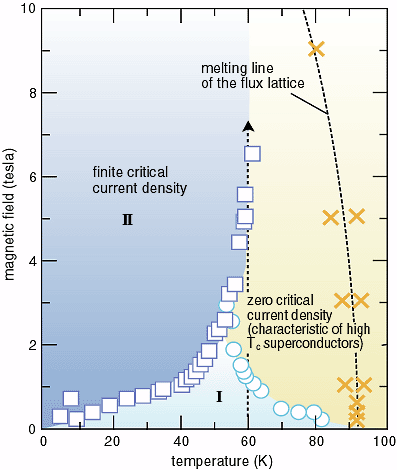In superconducting materials, the electrical resistivity drops
abruptly to zero at low temperature. The ultimate knowledge of
the critical current density, which is defined as the largest
current density flowing while keeping the zero resistance state
in the applied magnetic field, is required for the practical application
of superconducting materials. Since the critical current density
is closely related to the movement of the magnetic flux (vortices)
due to an applied magnetic field, the completion of the magnetic
phase diagram, which shows the correlation between the critical
current density, the applied magnetic field and also temperature,
is an indispensable study for the practical application of superconductors.
The critical current density is deduced from the magnetization
curve measured as a function of the applied magnetic field as
shown in Fig. 3-13. From the measurement of the magnetization
curve for a high Tc superconductor (YBa2Cu3Ox) of a high quality, a new peculiar vortex phase was found as
shown in Fig. 3-14. In conventional superconductors (the highest
transition temperature Tc is 25 K), the superconductors in an applied magnetic field above
the critical field always show finite electrical resistance, as
a result of the transition to normal conductors like normal metals,
at a certain temperature; this means zero critical current density
above the critical magnetic field. However, in a high Tc superconductor (as seen along the broken line and arrow in Fig.
3-14), when the applied magnetic field is increased from low to
high field at a constant temperature, it is found (in this study)
that the critical current density changes from finite to zero
to finite current density; that is, a region of zero current density
exists between regions of finite current densities. Many discoveries
for vortex systems have been made successively since the discovery
of high Tc superconductors in 1987, and a new field is now growing in physics:
"vortex matter." |

